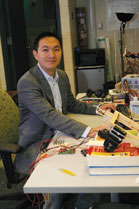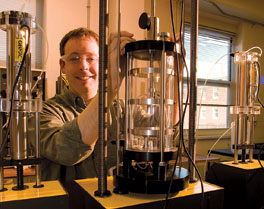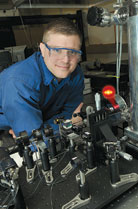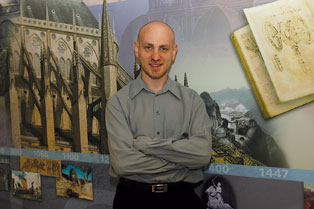Wide-ranging work draws national recognition
RESEARCH |
Four assistant professors recently won prestigious and highly competitive national awards designed to support the research of particularly promising faculty members early in their careers.
Jingyi Yu, computer and information sciences, Matthew Doty, materials science and engineering, and Christopher Meehan, civil and environmental engineering, received Early Career Development Awards from the National Science Foundation, and Joshua Zide, materials science and engineering, was selected by the Office of Naval Research for its Young Investigator Award.
Jingyi Yu, computational photography

Imagine an imaging system that would allow a surgeon to see an organ from all angles before making the first cut with a scalpel, or a law enforcement agent to determine not only the speed of a car as it races through a red light but also the number on its license plate.
Yu is studying multi-perspective imaging, rendering and projection—all techniques that have the potential to dramatically change how images are captured, delivered and viewed by the human eye.
The technology, which combines computer graphics, vision and photography, yields images similar to those created by artists in the cubist movement, where objects are depicted from multiple viewpoints to show the subject in a broader context. The goal of Yu’s research project is to develop a complete framework to characterize and design new multi-perspective cameras and displays and to use these systems for computer vision and graphics applications.
His work focuses on the lens and aperture system of a camera.
“A typical pinhole camera works like the human eye, capturing what’s known as a perspective image,” he says. “In contrast, a multi-perspective camera works more like a fly’s vision system, which includes many small eyes that work together to yield a single multi-perspective image from a number of individual images.”
Yu’s research will focus not only on development of the camera itself, but also on its use for three-dimensional reconstruction and on generation of a multi-perspective projection system that would allow a scene to be viewed in a panoramic way.
Christopher Meehan, slickensided surfaces

Meehan’s research project on the seismic behavior of slickensided surfaces will include a service-learning outreach program focused on engineering reconnaissance in the aftermath of natural disasters.
Slickensides are surfaces of weakness formed in stiff clays or clay shales as a result of large shear displacements concentrated on a discrete surface of sliding. Meehan explains that the low shear strength associated with slickensided surfaces is a significant source of slope stability problems in many regions.
“Even if slickensided slopes and the structures they support are stable under static load conditions,” he says, “movement along pre-existing slickensided rupture surfaces can represent a critical mechanism for sliding during earthquakes.”
Little information is currently available concerning the shearing resistance that can be mobilized along pre-existing slickensided rupture surfaces under seismic loading conditions. To address this lack of understanding, Meehan plans to develop a unique torsional shear device that will be used to form slickensided shear planes in clay soils and to measure the static and cyclic shear strengths along these surfaces.
“We plan to use this device to test a wide variety of pure clay minerals and natural clay soils to develop a fundamental understanding of the seismic behavior of slickensided shear surfaces,” he says.
“My educational goal is to develop a new, non-traditional learning environment outside the classroom that will bring the students to the problem and excite them about engineering using a novel approach. Observing catastrophic engineering failures caused by natural disasters will be an eye-opening experience for many undergraduate students.”
Matthew Doty, quantum dot molecules

Doty works with quantum dots (QDs), which often are referred to as “artificial atoms” because, like natural atoms, they have bound, discrete electronic states. Recent advances in materials science and nanofabrication techniques have made it possible to controllably couple individual QDs to create artificial molecules.
In contrast to natural molecules, however, where the degree of coupling is determined by the electro-negativity of each atom and the spacing between the atoms, in QD molecules, the coupling can be engineered.
“This control over quantum mechanical coupling at the level of single electrons and holes opens the door for design of novel materials with revolutionary properties,” Doty says. The applications for this technology include optoelectronic devices such as lasers and sensors, quantum information processing and functional materials.
In order to use the QD molecules (QDMs) in future technologies, Doty says, “We have to understand the signatures and mechanisms of quantum mechanical coupling. This will require identifying their unique properties at the single molecule level while also figuring out how to scale the process up to increase the size of QDM assemblies.”
He also plans to host two high school teachers in his lab each summer and to create a portable experiment demonstrating the application of spectroscopy to materials characterization that teachers can borrow for use in their classrooms.
“In the long term,” he says, “I’d like to build a library of these types of modules to serve as a resource for middle- and high-school teachers.”
Joshua Zide, new semiconductor materials

Zide’s research focuses on incorporating bismuth into compound semiconductors, an achievement that has been reported in only three labs throughout the world and none in the U.S. His work expands these bismide materials onto different substrates from previous efforts.
“Dilute bismides are a new, virtually unexplored and extremely promising material system for thermoelectric power generation,” Zide says. “They offer the potential for significant reduction in thermal conductivity and improvements in electronic properties over other semiconductors in this class, enabling high-efficiency thermoelectric materials.”
Thermoelectric devices create a voltage when there is a different temperature on each side. Conversely, application of a voltage to such a device creates a temperature difference. This effect can be used to generate electricity, as well as to heat or cool objects.
“Thermoelectric conversion is analogous to the work done by a solar cell, but it uses heat rather than light,” Zide says, adding that one potential application is in hybrid cars, where excess heat could be converted to energy.
For now, however, he is interested in the basic science, and he knows there will be challenges in growing the material. But his best guess is that the new materials will offer exceptional efficiency, which he notes is important to the Office of Naval Research (ONR).
“Thermoelectric power generation is highly relevant to ONR’s mission and goals,” Zide says. “For several naval customers, waste heat recovery is extraordinarily important, and efficient thermoelectric power generation is an attractive technology.”
Article by Diane Kukich, AS ’73, ’84M
Editor’s note: As the UD Messenger was preparing to go to press, additional early career awards were being announced. Winners include E. Fidelma Boyd and Jack Puleo, assistant professors, who will be among the researchers featured in our next issue.





